By Jussi Parikka, University of Southampton
The Earth recently entered a new epoch – the Anthropocene. Since the dawn of modern mechanised industry and the use of fossil fuels, the story goes that human beings have become the dominant force for change in our atmosphere, seas and land.
It is a compelling idea – and the Anthropocene has generated public interest as well as academic debate. For instance, academics still aren’t agreed on a start date for the epoch. A recent article published by the Anthropocene Working Group, suggests that the first nuclear test at Los Alamos in 1945 should be used as the milestone.
Geologists are now beginning to consider the knock-on global effect that the economy, government, and even news and arts media may have on our Earth. Donna Haraway, a philosopher at University of California at Santa Cruz, uses the term “Capitalocene” to emphasise the link to global economies.
When future generations dig into the earth, they will find huge seams of media – books, hard discs, DVDs – a fossil record which can be playfully referred to as the “geology of media”.
Thoughts can move mountains
Politics, architecture and design can have a direct effect on geology. In Singapore, the demand for the expansion of their border is so great that huge volumes of sand, used for coastal earthworks, are bought and traded from foreign countries. Sand has been called the “most wanted raw material on the planet” and is now a matter of national security for Singapore.
In addition to media waste and artificial islands, future geologists will encounter a vast amount of electronic waste. In January, Apple reported its one billionth iOS device sold, a symbol of the sheer quantity of electronic devices in the world. Indeed, several major corporations including Apple have been criticised for adopting design strategies which fail to take into account their environmental impact. The Internet of Things is expected to further accelerate this growing problem of technological junk.
Cultural and media studies scholar Toby Miller argues:
We have neglected the dirty, material origins and processes that characterise communications technologies like tablets, phones, and laptops. We have forgotten the real story of Cold War militarism, undersea cables, conflict minerals, slave labour, toxic exposure, and illegal recycling.
The picture is even worse when we consider the final resting place of most digital hardware. The environmental impact of media technology is not fairly distributed between nations. While you may curse the occasional discarded TV on your way to work, the amount of electronic residue in Pakistan is measured in millions of tons, because a lot of waste from developed countries ends up there.
Besides NGO and scholarly work on e-waste, the Anthropocene has given new inspiration to contemporary artists. Exhibitions such as Rare Earth – showing in February at the Thyssen-Bornemisza Art Contemporary in Vienna – consider the relationship between technology, culture and the planet. In Berlin, the Haus der Kulturen der Welt recently finished a massive multi-year project on the Anthropocene that curated exhibitions, talks, publications and a public visibility for a concept that has unified the humanities, earth and climate science.
Shaped by its time
In The Last Pictures, American artist Trevor Paglen sent images into orbit aboard a satellite. The project addresses technological waste in space and the memory embedded in the images – which may outlast human life on this planet.
Katie Paterson’s practice touches on the way in which natural processes can participate in our cultural life. Her Future Library project focuses less on the content than the source of her paper, which is grown in a forest in Norway. In 100 years time, timber from this forest will provide the raw material for a library of books written by a variety of authors.
While the modern concept of the Anthropocene is undoubtedly very young, existing as it does in the context of anthropogenic climate change, similar ideas have been proposed in the past. In 1873, geologist Antonio Stoppani proposed the idea of an “Anthropozoic period”, emphasising the impact of human life on the globe. Stoppani pointed out science and technology were creating a new order of nature. A future alien intelligence would investigate relics of this progress as the fossils of our age. Stoppani was ahead of his time; his ideas were deemed unscientific, and he was ignored.
Now the revival of the Anthropocene is creating new ways of considering art history and cinematic culture. These ideas will shape the way in which we think about design, architecture and art.
This is the other side of the story concerning the media of the Anthropocene. It is not merely the publicity of the concept but how under this umbrella, media studies, design, art and humanities consider their relation to the planetary and geographical scales.
![]()
This article was originally published on The Conversation.
Read the original article.



